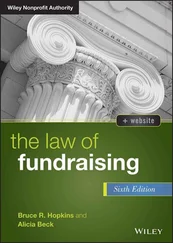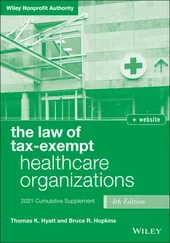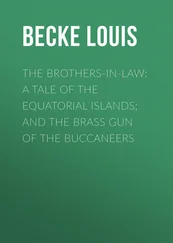Bruce R. Hopkins - The Tax Law of Charitable Giving
Здесь есть возможность читать онлайн «Bruce R. Hopkins - The Tax Law of Charitable Giving» — ознакомительный отрывок электронной книги совершенно бесплатно, а после прочтения отрывка купить полную версию. В некоторых случаях можно слушать аудио, скачать через торрент в формате fb2 и присутствует краткое содержание. Жанр: unrecognised, на английском языке. Описание произведения, (предисловие) а так же отзывы посетителей доступны на портале библиотеки ЛибКат.
- Название:The Tax Law of Charitable Giving
- Автор:
- Жанр:
- Год:неизвестен
- ISBN:нет данных
- Рейтинг книги:5 / 5. Голосов: 1
-
Избранное:Добавить в избранное
- Отзывы:
-
Ваша оценка:
- 100
- 1
- 2
- 3
- 4
- 5
The Tax Law of Charitable Giving: краткое содержание, описание и аннотация
Предлагаем к чтению аннотацию, описание, краткое содержание или предисловие (зависит от того, что написал сам автор книги «The Tax Law of Charitable Giving»). Если вы не нашли необходимую информацию о книге — напишите в комментариях, мы постараемся отыскать её.
The Tax Law of Charitable Giving — читать онлайн ознакомительный отрывок
Ниже представлен текст книги, разбитый по страницам. Система сохранения места последней прочитанной страницы, позволяет с удобством читать онлайн бесплатно книгу «The Tax Law of Charitable Giving», без необходимости каждый раз заново искать на чём Вы остановились. Поставьте закладку, и сможете в любой момент перейти на страницу, на которой закончили чтение.
Интервал:
Закладка:
During the course of the tender offer, the donors transferred some of their stock in the corporation to three charities. Two of them were family foundations created on August 26, 1988. Various letters to the stockbroker authorizing the transfers were ostensibly executed in August 1988. The date the broker formally transferred title to the securities to the charities was September 8, 1988. Final letters of authorization were signed the next day.
The donors contended that the date of delivery of the stock directly to the charities was September 8, 1988—the date the broker prepared the documentation formally transferring title to the securities. They also contended, however, that the stockbroker was acting as agent for the charities, so that the dates of delivery of the stock were in August 1988. Both arguments were rejected by the court. The gift completion date was found to be September 9, 1988, with no transfer that was legally binding and irrevocable until then, and it was held that the stockbroker did not function as agent for the charities before that date.
The courts determined that the stock in this case had ripened from an interest in a viable corporation to a fixed right to receive cash by August 31, 1988—the date by which more than one-half of the stock had been tendered. That is, by that date, the courts held, it was practically certain that the tender offer and the merger would be successfully completed. The donors argued, unsuccessfully, that the stock did not ripen until September 12, 1988, because the tender offer and the merger could have been derailed. The likelihood of that happening was viewed by the courts as remote and hypothetical at best. Thus, because the fixed right to receive the money ripened as of August 31, 1988, and the gifts did not formally become effective until September 9, 1988, the gain was taxable to the donors. 37
§ 4.7 CONTRIBUTIONS OF COPYRIGHT INTEREST
Another item of intangible personal property that, to be transferred, must be passed in a formal manner is a copyright interest. A determination as to whether a properly completed transfer of a copyright interest occurred is essentially governed by state law, but only after certain federal law restrictions are satisfied. 38 The federal requirements involve a written transfer instrument signed by the donor as owner. 39 A copyright certificate is issued; however, possession of the certificate does not constitute ownership of the copyright itself. 40
In one instance, an individual physically presented to a charitable organization a copyright certificate for a book that was generating royalties, in an attempt to make a charitable gift. There was no executed written transfer instrument, and no formal action was taken by the recipient organization to formally transfer the copyright to itself. A court held that “[t]herefore, standing alone, . . . [the individual's] physical presentation of the copyright certificate to . . . [the charitable organization], although accomplished with much ceremony, was insufficient to transfer a legal interest in the copyright” to the charity. “This invalid transfer,” the court continued, “does not begin to qualify as a deductible charitable contribution.” 41
§ 4.8 CONTRIBUTIONS BY MEANS OF NOTES
The making of a note promising to pay money and/or transfer property to a charitable organization, and delivery of the note to the charity, does not create a charitable contribution deduction. This is because a mere promise to pay does not effect transfer of title to the property. 42 Of course, when the money and/or property is actually transferred to the charitable donee in satisfaction of the requirements of the note, an income tax charitable contribution deduction results. 43 (A promissory note is an item of intangible personal property.)
These distinctions are based on the rule that a charitable deduction is available only for the year the contribution is actually paid. 44 Delivery of a note is not payment of the amount it represents.
A note in these circumstances may bear interest, or purport to bear interest. The tax consequences of payment of the interest depend on the enforceability of the note. If the note is enforceable, the payment of interest on the note is not likely to be deductible as an interest expense; if the note is not enforceable, the additional amounts paid are not interest for tax purposes, but are deductible as charitable contributions. 45
§ 4.9 CONTRIBUTIONS BY LETTERS OF CREDIT
A charitable contribution made by means of an irrevocable banker's letter of credit is the basis of a charitable deduction as of the date the letter of credit was established. This is because an irrevocable letter of credit from a bank is the equivalent of money. 46
In one instance, an individual established an irrevocable banker's letter of credit in favor of a charitable organization. The letter of credit was for an aggregate amount of $150,000, payable by drafts drawn by the charity. The entire $150,000 was distributed to the charitable organization in four amounts, one in the year the letter of credit was established and the other three in the subsequent year. The IRS ruled that the entire $150,000 was deductible by this individual for the year in which the letter of credit was established, because the full amount was made available without restriction to the charitable organization. The fact that the charity withdrew only a portion of the amount available during the first year was held to be immaterial, because the charitable organization could have withdrawn the entire amount. 47
§ 4.10 CONTRIBUTIONS OF PROPERTY SUBJECT TO OPTION
A person may own an item of property and create an option by which another person may purchase the property at a certain price at or during a certain time. An option may be created for or transferred to a charitable organization. There is no federal income tax charitable contribution deduction, however, for the transfer of property subject to an option to a charitable organization. Rather, the general rule is that the charitable deduction arises at the time the option is exercised by the charitable donee. 48
Thus, the transfer to a charitable organization of property subject to an option by the option writer is similar to the transfer of a note or pledge by the maker (see previous discussions). In the note situation, there is a promise to pay money at a future date; in the pledge situation, there is a promise to pay money or transfer some other property, or to do both, at a future date. In the option situation, there is a promise to sell property at a future date.
These rules were interrelated by the IRS with the private foundation restrictions 49 in an instance involving a pledge by a corporation of an option on its common stock to a private foundation. The option document permitted the foundation to transfer the option to one or more charitable organizations, but the foundation decided not to exercise the option. The corporation was a disqualified person with respect to the foundation, 50 and the transaction would have been an act of self-dealing. 51 Thus, the foundation was to sell the option, at its fair market value, to an unrelated charitable organization. The IRS ruled that the corporation will be entitled to a charitable contribution deduction in the year the charitable organization exercises the option and that the amount of the contribution will be the excess of the fair market value of the stock at the time the option is exercised over the exercise price. 52
A charitable deduction can also arise when the option expires. In one instance, an S corporation executed a deed, contributing a tract of land to a charitable organization; the corporation retained an option to repurchase the land for a nominal amount. The IRS concluded that there was more than a remote possibility that the option would be exercised. The gift was made in 1993; the option was set to expire in 1995. For 1993, each of the shareholders of the corporation claimed a charitable contribution deduction for their share of the fair market value of the property. The IRS, however, determined that, because of the option, there could not be charitable deductions for 1993, but that the deductions could be taken with respect to 1995. 53
Читать дальшеИнтервал:
Закладка:
Похожие книги на «The Tax Law of Charitable Giving»
Представляем Вашему вниманию похожие книги на «The Tax Law of Charitable Giving» списком для выбора. Мы отобрали схожую по названию и смыслу литературу в надежде предоставить читателям больше вариантов отыскать новые, интересные, ещё непрочитанные произведения.
Обсуждение, отзывы о книге «The Tax Law of Charitable Giving» и просто собственные мнения читателей. Оставьте ваши комментарии, напишите, что Вы думаете о произведении, его смысле или главных героях. Укажите что конкретно понравилось, а что нет, и почему Вы так считаете.












